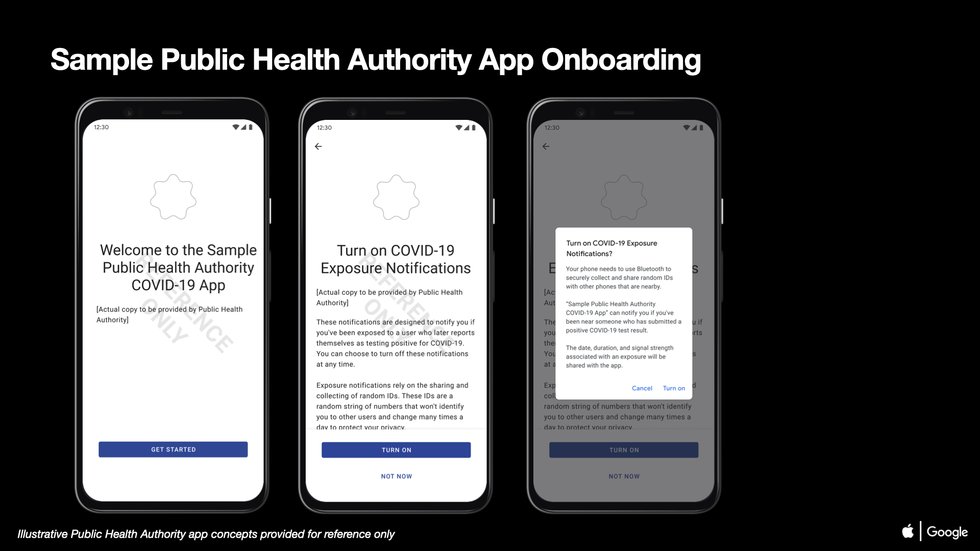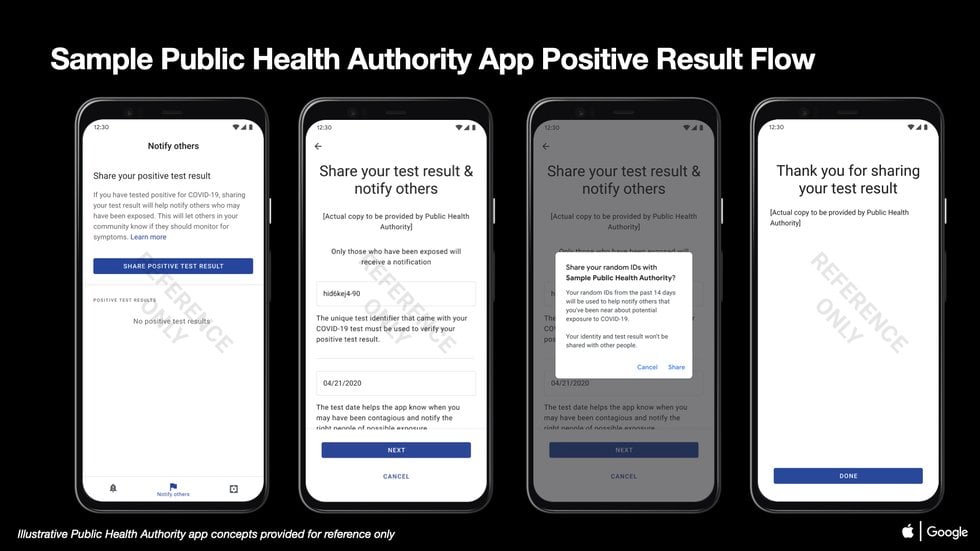
Apple and Google have teamed up to provide resources for public health authorities around the world to implement digital contact tracing for COVID-19. The tech giants are not building an app themselves, but are providing the technical foundations for public health organizations to build their own apps for exposure notification.
This week, the companies released sample user interfaces and sample code for iOS and Android to support app developers. Here’s what it could look like, based on sample interfaces provided by Apple and Google:
In the interest of “privacy, consent and control,” Google and Apple are requiring app developers to adhere to some conditions. The first is that apps must require users to consent before the app can use the API.

An app would require users to consent before sharing a positive test result with the public health authority.

The app would use Bluetooth to tell users who’ve enabled notifications if they’ve been in contact with a possible exposure. Apps are prohibited from using location services, or even asking for permission.

As countries have been implementing digital tracing technology, privacy and surveillance experts have put their guards up, warning that any digital data collection should include firm end dates (aka sunset clauses), provisions that data can only be collected in relation to the coronavirus pandemic and that it will be deleted as soon as it’s no longer needed.
For their part, Apple and Google specify that apps should only collect the minimum amount of data necessary and can only use that data for COVID-19 response efforts, prohibiting any other uses of data, including targeted advertising. But there will necessarily be some difference in how Google and Apple’s API is implemented based on the developer and public health agency.
Will our public agencies use digital contact tracing apps?
Prime Minister Justin Trudeau has said the country is looking at potentially using digital technology to track and fight the virus, but hasn’t shared any specifics about who the Canadian government might be talking to.
The Public Interest Advocacy Centre (PIAC) has filed an application with the Canadian Radio-television and Telecommunications Commission (CRTC) requesting disclosure of who they’re working with, including telecommunication companies.
“PIAC is seeking oversight, clarity and transparency from the CRTC so that Canadians know what role their mobile wireless service providers and home internet providers may play in COVID-19 tracking and that they appropriately safeguard privacy while not in any way impeding appropriate public health measures,” said PIAC executive director John Lawford in a statement.
In an email to NOW last week, Toronto Public Health (TPH) associate medical officer of health Vinita Dubey said the city agency is following the guidance and recommendations of provincial and federal governments and public health officials, but is not currently in discussion with Apple or Google about the software.
“TPH is aware that Apple and Google are collaborating on software that may allow individuals to identify who individuals were in close contact with (within 30 metres) to support contact tracing. We are not aware that this type of software is currently available in Canada.”
Ontario has been criticized for its slow contact tracing, which requires an investigator to perform a detailed investigation for each new positive coronavirus case, notifying close contacts to self-identify immediately.
Dubey says case and contract tracing is critical to TPH’s COVID-19 response, providing insight in how the virus spreads, how long it can incubate and how it spreads in the community and affects our health. TPH recently switched to a new contact tracing system, the Coronavirus Rapid Entry Case and Contact Management System (CORES), to document each individual case investigation quicker and more efficiently.
“Previously, TPH was inputting our case and contact tracing data into the provincial integrated Public Health Information System (iPHIS) that all local public health departments are required to use to report infectious disease information,” says Dubey. “While iPHIS has served us for many years during routine public health work, for the purposes of the current COVID-19 emergency, we quickly realized that this provincial information system was not well equipped to deal with a health emergency of this magnitude and the scale and speed of data entry required to provide up-to-date data. Additionally, the information from CORES can be used to provide analysis and report numbers provincially.”
CORES prioritizes cases that require urgent follow-up, including healthcare workers and those in congregate settings like long-term care homes. It also allows more frontline TPH staff to work from home (the agency recently had its own outbreak).
“Data is core to informing our response to COVID-19. It is the only way we will understand where and how this new virus is spreading and its overall impacts on our health and what we can to do further protect our residents, especially those who are most vulnerable.”
It would stand to reason that Toronto would use the tools that would make data quicker to trace and more widely available. But time will tell how it will be used and by whom.












